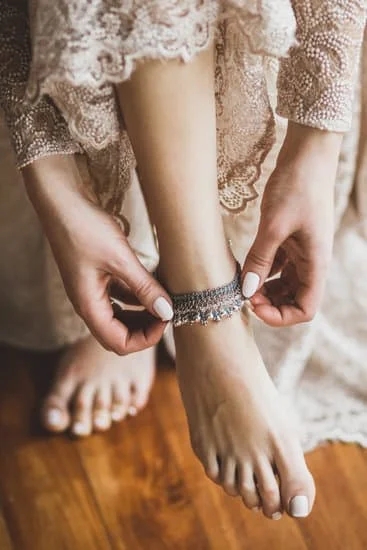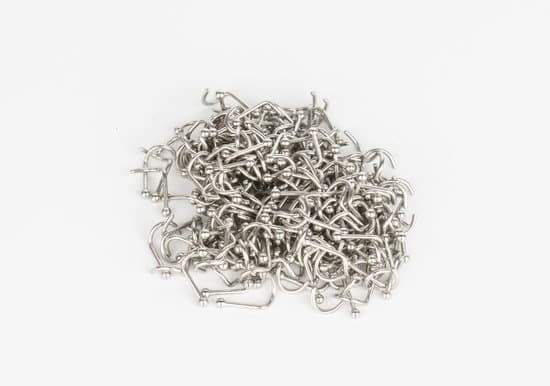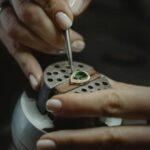Gold jewelry is a timeless and elegant accessory that can instantly elevate any outfit. However, over time, it is natural for gold jewelry to lose its luster and shine due to exposure to various elements. This is why knowing how to polish gold jewelry is essential in maintaining its beauty and quality.
Properly maintaining your gold jewelry through regular cleaning and polishing not only ensures that it looks its best but also helps preserve its value. By understanding the different types of gold used in jewelry and the specific polishing process for each, you can effectively keep your favorite pieces looking as good as new.
In this article, we will explore the importance of keeping gold jewelry clean and well-maintained, understand the different types of gold used in jewelry, and provide a step-by-step guide on how to polish your treasured pieces at home. Additionally, we will discuss common mistakes to avoid when polishing gold jewelry, alternative polishing methods, and the importance of regular cleaning and maintenance for long-lasting sparkle.
Whether you have yellow gold, white gold, or rose gold jewelry, this comprehensive guide will help you keep them gleaming for years to come. So let’s delve into the world of gold jewelry polishing and ensure that your beloved pieces continue to sparkle and shine.
Understanding Different Types of Gold
When it comes to gold jewelry, there are various types of gold used, with each type having its own unique characteristics and properties. Understanding these different types of gold is essential when it comes to effectively polishing and maintaining your jewelry.
Types of Gold Used in Jewelry
One of the most common types of gold used in jewelry is 14 karat gold, which consists of 58.5% pure gold mixed with other metals such as copper and silver. This type of gold is known for its durability and affordability, making it a popular choice for everyday pieces. Another popular option is 18 karat gold, which contains 75% pure gold and is often favored for its rich color and higher purity.
Effects on the Polishing Process
The type of gold used in jewelry can have an impact on the polishing process. For example, while 14 karat gold may be more resistant to tarnishing, it may require more frequent polishing to maintain its shine due to the presence of other metals. On the other hand, 18 karat gold’s higher purity makes it less prone to tarnishing but may require gentler cleaning solutions and techniques to avoid damage.
Understanding the specific type of gold used in your jewelry allows you to tailor your polishing approach accordingly, ensuring that your pieces are cleaned and maintained effectively without causing any damage.
Considerations for Different Types of Gold
When polishing different types of gold, whether it’s yellow gold, white gold, or rose gold, it’s important to consider their individual characteristics. Yellow gold tends to be more forgiving when it comes to polishing due to its natural luster, while white or rose gold may require specialized care to preserve their unique colors. By understanding the intricacies of each type of gold, you can ensure that your jewelry receives the appropriate treatment for optimal results.
Tools and Materials Needed
When it comes to polishing gold jewelry, having the right tools and materials is essential for achieving that beautiful, shiny finish. The first and most important item you will need is a gentle cleaning solution specifically designed for gold jewelry. This can be found at most jewelry stores or even made at home using a mixture of mild soap and warm water.
In addition to the cleaning solution, you will also need a soft, lint-free cloth for buffing the jewelry to a shine. Microfiber cloths work particularly well for this purpose, as they are gentle on delicate gold surfaces. For more stubborn tarnish or dirt, you may want to invest in a polishing pad or cloth specifically designed for gold jewelry. These pads are often infused with a gentle polishing compound that can help restore the luster of your gold pieces.
It’s important to note that while these tools and materials are commonly used for polishing all types of gold jewelry, certain types of gold may require specific care. For example, white gold jewelry may benefit from a white gold-specific cleaning solution to maintain its distinct color.
When selecting your tools and materials, consider the type of gold jewelry you own and choose products that are suitable for its specific composition. By doing so, you can ensure that your beloved gold pieces receive the best possible care when it comes time to polish them.
Step-by-Step Polishing Process
When it comes to polishing gold jewelry, it’s important to follow a step-by-step process to ensure that your pieces are cleaned and buffed to a beautiful shine without causing any damage. Whether you’re working with solid gold, 10k, 14k, or 18k gold, the following guide will help you achieve a professional-looking polish at home.
Prepping the Jewelry
Before diving into the polishing process, it’s essential to prep your gold jewelry. Start by removing any dirt or debris from the piece using a soft-bristled brush or cloth.
If there are gems or delicate areas on the jewelry, consider using a gentle cleaning solution specifically designed for jewelry to ensure they are not damaged during the polishing process. Additionally, be sure to lay down a soft cloth or towel on your work surface to protect the metal from scratches.
Applying the Cleaning Solution
Once your jewelry is prepped and ready for polishing, it’s time to apply the cleaning solution. There are many commercial jewelry cleaners available on the market specifically formulated for gold. Alternatively, you can create a DIY solution using mild dish soap and warm water. Using a soft cloth or brush, gently rub the cleaning solution onto the surface of your gold jewelry, paying extra attention to any tarnished areas.
Buffing to a Shine
After applying the cleaning solution and allowing it to sit for a few minutes (as directed on the product label), it’s time to buff your gold jewelry to a high shine. Using a clean, dry microfiber cloth or a dedicated polishing pad, begin rubbing the jewelry in small circular motions. This will help remove any remaining residue and bring out the lustrous shine of your gold pieces.
Be sure to use light pressure and avoid over-buffing which can cause unnecessary wear on the metal. Once complete, admire your beautifully polished gold jewelry.
Tips for Polishing Different Types of Gold
When it comes to polishing gold jewelry, different types of gold require different care and attention. White gold, for example, is usually plated with rhodium to enhance its appearance, so it needs to be handled with care to avoid affecting the plating.
On the other hand, rose gold has copper mixed in with the gold alloy which can give it a unique color but also makes it more susceptible to tarnishing. Therefore, it’s important to know how to properly polish each type of gold to ensure that your jewelry maintains its beauty and luster.
For white gold jewelry, it’s essential to use gentle cleaning solutions and soft cloths to avoid scratching or wearing down the rhodium plating. Avoid using abrasive materials or harsh chemicals as these can damage the surface of the metal. Similarly, when polishing rose gold pieces, opt for non-abrasive cleaners and a gentle touch during buffing to maintain the color and shine of the jewelry.
Furthermore, knowing when not to polish certain types of gold is just as important as knowing how to polish them. For example, matte or satin-finished gold should not be polished in the traditional sense, as doing so will remove their unique finish.
In such cases, professional cleaning services that specialize in these finishes may be recommended for maintaining their original look. Understanding these specific tips and techniques for polishing different types of gold will help you keep your jewelry looking beautiful for years to come.
| Gold Type | Polishing Tips |
|---|---|
| White Gold | Use gentle cleaning solutions and soft cloths; Avoid abrasive materials or harsh chemicals. |
| Rose Gold | Opt for non-abrasive cleaners and a gentle touch during buffing; Avoid harsh chemicals that can affect its unique color. |
Cleaning and Maintenance
Gold jewelry requires regular cleaning and maintenance to keep it looking its best. In addition to the polishing process, there are other important steps to take in order to properly care for gold jewelry. Here are some tips for cleaning and maintaining your gold jewelry:
1. Regular Cleaning: Gold jewelry should be cleaned regularly to prevent the buildup of dirt, oils, and other substances that can dull its shine. Use a mild cleaning solution and a soft cloth to gently wipe down the surface of the jewelry.
2. Storage: Proper storage is crucial for maintaining the luster of gold jewelry. Store each piece separately in a soft pouch or lined jewelry box to prevent scratching and tangling.
3. Professional Inspections: It is advisable to have your gold jewelry professionally inspected and cleaned at least once a year. Jewelers have the expertise and tools needed to thoroughly clean and inspect your pieces for any necessary repairs.
4. Avoid Harsh Chemicals: When cleaning gold jewelry at home, be sure to avoid using harsh chemicals or abrasive materials that can damage the metal or gemstones. Stick to gentle cleaning solutions specifically designed for use on gold.
5. Routine Maintenance: Regular maintenance may include tasks such as checking clasps, prongs, and settings for signs of wear, ensuring all pieces are secure.
By following these guidelines for cleaning and maintaining your gold jewelry, you can ensure that your pieces retain their luster and beauty for years to come.
Tools Needed for Polishing Gold Jewelry
Common Mistakes to Avoid
When polishing gold jewelry, it’s essential to be aware of common mistakes that people often make in the process. Avoiding these mistakes can help preserve the quality and appearance of your gold jewelry for years to come. Here are some common errors to steer clear of when polishing your gold pieces:
- Using the wrong cleaning solutions: One of the most common mistakes when polishing gold jewelry is using harsh or abrasive cleaning solutions. These solutions can damage the metal and any gemstones on the jewelry. Instead, opt for gentle, specially formulated jewelry cleaning solutions that are safe for gold.
- Over-buffing: Another mistake is overdoing it when buffing the gold jewelry. While it’s important to buff the jewelry to achieve a shine, excessive buffing can actually wear away at the metal and lead to a loss of detail and luster. Be gentle and use light pressure when buffing.
- Skipping professional cleanings: Many people make the mistake of solely relying on DIY at-home polishing methods and neglecting professional cleanings. Professional jewelers have specialized equipment and expertise to properly clean and polish gold jewelry without causing any damage. It’s recommended to schedule a professional cleaning at least once a year.
Taking care to avoid these mistakes will ensure that you keep your gold jewelry looking beautiful without compromising its quality.
Lastly, remember that prevention is key when it comes to maintaining your gold jewelry’s shine, so consider taking off your gold pieces before engaging in activities that could expose them to chemicals or rough surfaces.
Alternative Polishing Methods
In conclusion, knowing how to polish gold jewelry is essential for maintaining its beauty and longevity. Keeping gold jewelry clean and well-maintained not only preserves its luster but also ensures that it retains its value over time. By understanding the different types of gold used in jewelry and the specific polishing process required for each, individuals can effectively care for their precious pieces.
When it comes to polishing gold jewelry, having the right tools and materials is crucial. Whether it’s using cleaning solutions, cloths, or polishing pads, having the proper supplies on hand makes the process much easier. Following a step-by-step polishing process and being mindful of specific tips for different types of gold, such as white gold or rose gold, will help ensure that jewelry is kept in top condition.
Beyond just polishing, regular cleaning and maintenance are also vital for keeping gold jewelry looking its best. Additionally, by being aware of common mistakes to avoid when polishing gold jewelry and exploring alternative methods like natural DIY solutions or professional cleaning services, individuals can maintain their treasured pieces with ease. With these techniques in mind, anyone can confidently keep their gold jewelry shining for years to come.
Frequently Asked Questions
What Is the Best Way to Polish Gold Jewelry?
The best way to polish gold jewelry at home is to use a soft, lint-free cloth and gently rub the surface of the jewelry in small, circular motions. Avoid using abrasive or rough materials that can scratch the gold.
For stubborn dirt or tarnish, you can also use a mild soap and water solution, followed by thorough drying with a clean cloth.
How Can I Make My Gold Jewelry Shiny at Home?
There are several ways to make your gold jewelry shiny at home. One method is to soak the jewelry in a mixture of warm water and mild dish soap, then gently scrub it with a soft-bristled toothbrush.
Another option is to use a commercial jewelry polishing cloth, which is specially designed to remove tarnish and restore shine to gold jewelry. Additionally, using a jewelry cleaning solution specifically formulated for gold can also help maintain its shine.
How Do Professionals Polish Gold?
Professionals typically polish gold jewelry using specialized tools and equipment, such as ultrasonic cleaners and rotary tumblers. These machines facilitate deep cleaning and polishing of intricate designs or hard-to-reach areas on the jewelry.
Professionals may also use professional-grade polishing compounds or creams to remove tarnish and restore the luster of gold jewelry effectively. This process ensures that the jewelry is thoroughly cleaned and polished, resulting in a brilliant shine that may be challenging to achieve with household methods alone.

Welcome to my jewelry blog! My name is Sarah and I am the owner of this blog.
I love making jewelry and sharing my creations with others.
So whether you’re someone who loves wearing jewelry yourself or simply enjoys learning about it, be sure to check out my blog for insightful posts on everything related to this exciting topic!





